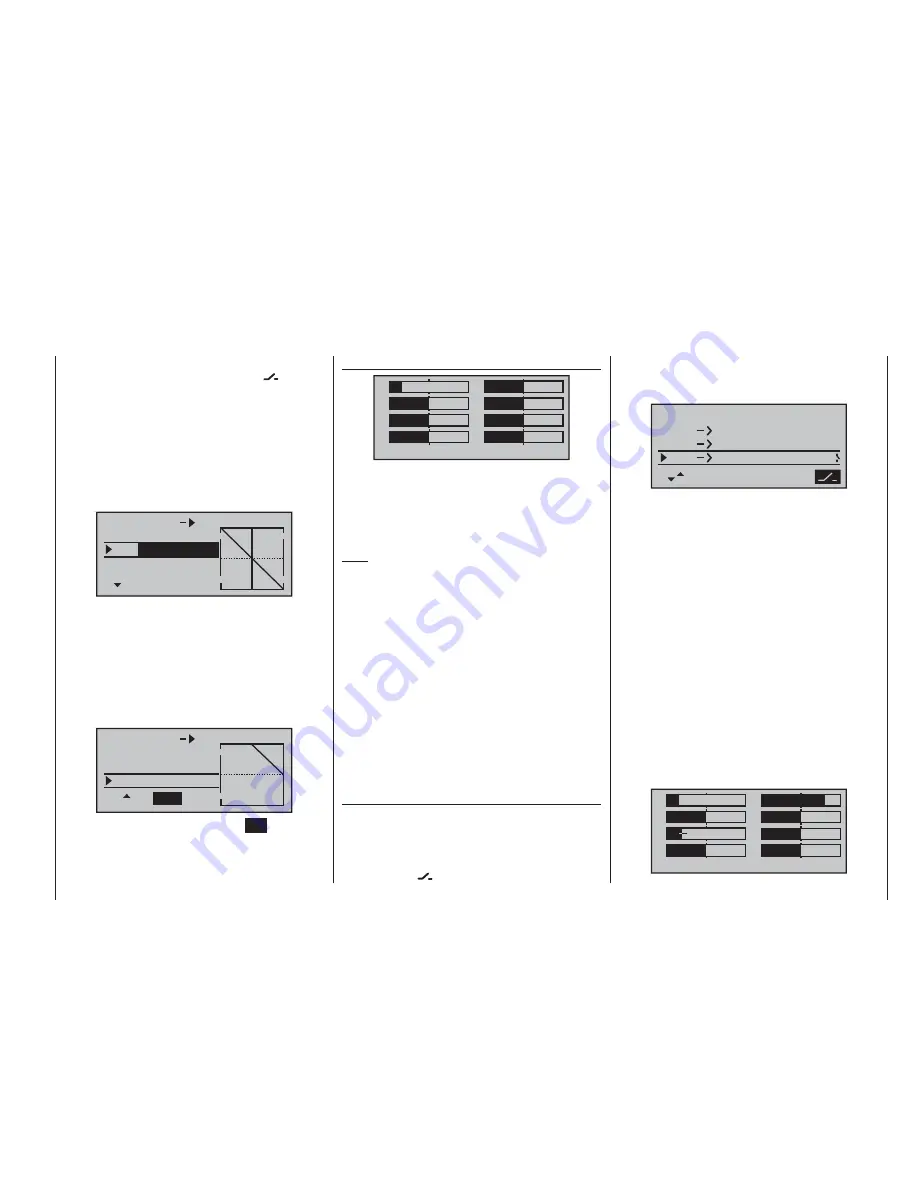
103
Programming example: fi xed-wing model
»Servo display«
(page 20)
1
3
5
7
2
4
6
8
0
%
0
0
%
0
0
%
0
0
%
0
0
%
0
0
%
0
–100%
0
%
0
… menu where you can immediately check the effect
of the settings you have entered so far: with the mixer
switched off, the bar display for Channel 1 follows the
movement of the Ch 1 stick. With the mixer switched on
it stops – as shown – at around -100%.
Note:
If you carry out this test with the receiving system
and power system switched on, please take great
care that you operate the change-over switch only
in the “motor OFF” position! If you ignore this, there
is a danger that the power system will be severely
overloaded by being switched on abruptly, and it
could even suffer damage. For the same reason
you should be careful only to use the change-over
switch at the “motor OFF” setting when you are fl y-
ing the model.
To conclude the programming procedure, move the
selected “change-over switch” back to the “motor ON”
position, i. e. “forward”; move back to the multi-function
menu and from there to the …
»wing mixer«
(page 72 … 76)
… menu where you can – assuming that you have not
already done this in your general model programming –
select the “brake
¼
aile” line and set the desired aileron
travel when the Ch 1 stick is operated in the
up
direction
(“Brake”). In the
(switch) column press the rotary
cylinder briefl y, then assign your selected “change-over
switch” by moving your preferred switch from “forward”
to “back”.
+ 33%
SEL
+ 50%
–
5%
+ 44%
3
d i f f a i l e .
a i l
rudd
brak
brak
elev
aile
If your model also features camber-changing fl aps, and
you have therefore selected “
2ail 2fl
” in the “aile / fl ap”
line of the
»base sett.«
menu, locate the “change-over
switch” you have just operated (in this case switch 1),
move it “forward” again and switch to the “brak
¼
fl ap”
line with the rotary cylinder pressed in. You can now set
the desired down-defl ection of the fl aps when the Ch 1
stick is moved (this fl ap position is termed “crow” or “but-
terfl y”; see also page 75), and assign the external switch
which also acts as the change-over switch, as already
described.
If you now switch back to the »
Servo display
« menu
and move the Ch 1 stick alone, you will see that the bar
display for Channel 1 either remains at around -100%
while the displays for channels 2 + 5 (and also the fl aps
6 + 7, if set up) follow the stick movement, or the other
way round: when the switch is operated, the latter stay
at around the mid-point, and only the Channel 1 display
moves.
1
3
5
7
2
4
6
8
0
%
0
0
%
0
0
%
0
0
%
0
–100%
0
%
0
89%
89%
+
… menu where you need to program a free mixer “c1
¼
c1”. When you have done this, move to the
(switch)
column and assign your selected “change-over switch”
to this mixer; for example SW 1. This is done by acti-
vating the switch assignment with a brief press on the
rotary cylinder, and moving the switch from “forward” to
“back”, i. e. towards you.
With the mixer switched on, move to the second screen
page, and there set a starting point of -100% for the
SYM
metrical mixer value.
MIX 1
c1
c1
trv
0%
offs
ASY
SYM
–100%–100%
+
Now hold the rotary cylinder pressed in to move to the
“Offs” line. The
SYM
and
ASY
fi elds are now replaced
by
STO
and
CLR
. With the
STO
button highlighted,
move the Ch 1 stick to the “forward” end-point and
press the rotary cylinder briefl y: the value to the right of
“Offs” now changes from 0% to approx. +100% and the
graphic display of the mixer curve displayed on the right
also changes accordingly:
trv
–100%
–100%
100%
offs
CLR
STO
+
MIX 1
c1
c1
Return to the basic display by pressing
ESC
, then press
the rotary cylinder briefl y to move to the …
Summary of Contents for mx-16 ifs
Page 1: ...mx 16 Programming Manual mx 16iFS 1 gb 3D CYLINDER ROTARY SELECT INTELLIGENT FREQUENCY SELECT...
Page 15: ...15 For your notes...
Page 31: ...31 For your notes...
Page 35: ...35 For your notes...
Page 39: ...39 For your notes...
Page 55: ...55 For your notes...
Page 65: ...65 For your notes...
Page 77: ...77 For your notes...
Page 104: ...104 For your notes...
Page 111: ...111 For your notes...
Page 128: ...128 For your notes 128...
Page 129: ...129 For your notes 129...
Page 130: ...130 For your notes...
















































